Background
Since Duke Bretislaus I of Bohemia had implemented the inheritance principle of agnatic seniority in the 11th century, the order of succession in Bohemia, many rivalling scions of the ramified Přemyslid dynasty waged war against each other. The claimants to the Prague throne sought for formal recognition by the Holy Roman Emperor, when in actuality, the accession required the active support by the Bohemian nobility.
The Přemyslid duke Vladislaus I of Bohemia, ruling since 1109, likewise had to struggle to consolidate his authority, defying the claims raised by his brother Bořivoj II who had reached his enfeoffment by Emperor Henry IV in 1101. When Vladislaus died in 1125 his succession was disputed among his surviving brother Soběslav I and his Moravian cousin Otto II, duke in Olomouc and Brno. Otto could appeal to the agnatic seniority principle, and he also reached the support of Vladislaus' widow Richeza of Berg and King Lothair III.
Battle of Chlumec
In November 1125 King Lothair met with Bavarian nobles in Regensburg. They settled for a campaign into Bohemia in favour of Otto the Black who, according to the chronicler Otto of Freising, had offered a considerable sum of money. The Bohemian nobles received an ultimatum either to expel Soběslav or to face a punitive expedition.
Duke Soběslav I, represented by negotiators in Regensburg, prepared for war. He made the Bohemian aristocracy rally to his support, strongly referring to the legacy of Saint Adalbert of Prague and Duke Wenceslas. In the winter of 1125–26 he had defensive works and encampments erected along the Kulmer Steig route, the presumed gateway of Lothair's troops. As the thaw set in, Lothair on February 18 crossed the Bohemian border at the Nakléřov Pass with his army and met Sobeslav's troops either near Chlumec or in the vicinity of the Lotarův vrch ("Lothair Mountain") near Jílové. The exact location of the battle is not known.
A vanguard of about 200 heavy armoured knights commanded by Otto the Black was immediately attacked by Bohemian forces in a narrow valley, while the main army under King Lothair found itself entrapped with no option to withdraw back to the mountain pass. The battle ended in a crushing defeat of the Imperial troops. Otto fell in action, and Lothair was captured with many of his liensmen like Margrave Albert the Bear and Landgrave Louis I of Thuringia. Soběslav won a convincing victory and released his captives on the condition of his investiture. [1]

Lothair III, sometimes numbered Lothair II and also known as Lothair of Supplinburg, was Holy Roman Emperor from 1133 until his death. He was appointed Duke of Saxony in 1106 and elected King of Germany in 1125 before being crowned emperor in Rome. The son of the Saxon count Gebhard of Supplinburg, his reign was troubled by the constant intriguing of the Hohenstaufens, Duke Frederick II of Swabia and Duke Conrad of Franconia. He died while returning from a successful campaign against the Norman Kingdom of Sicily.
Wenceslaus I, called One-Eyed, was King of Bohemia from 1230 to 1253.

The Duchy of Bohemia, also later referred to in English as the Czech Duchy, was a monarchy and a principality of the Holy Roman Empire in Central Europe during the Early and High Middle Ages. It was formed around 870 by Czechs as part of the Great Moravian realm. Bohemia separated from disintegrating Great Moravia after Duke Spytihněv swore fealty to the East Frankish king Arnulf in 895.

Boleslaus II the Pious, a member of the Přemyslid dynasty, was Duke of Bohemia from 972 until his death in 999.
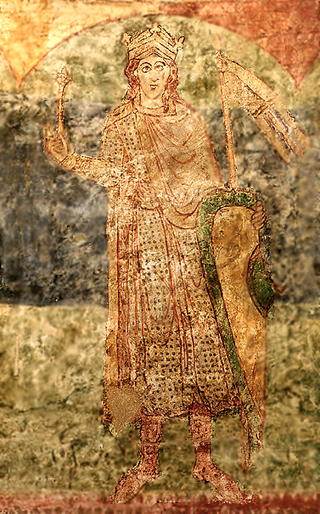
Vratislaus II, the son of Bretislaus I and Judith of Schweinfurt, was the first King of Bohemia as of 15 June 1085, his royal title granted as a lifetime honorific from Holy Roman Emperor Henry IV that did not establish a hereditary monarchy. Before his elevation to the royal dignity, Vratislaus had ruled Bohemia as duke since 1061.
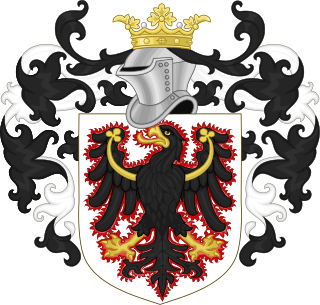
The Přemyslid dynasty or House of Přemysl was a Bohemian royal dynasty that reigned in the Duchy of Bohemia and later Kingdom of Bohemia and Margraviate of Moravia, as well as in parts of Poland, Hungary and Austria.

Svatopluk the Lion was Duke of Bohemia from 1107 until his assassination in 1109. His rule was overshadowed by the fierce conflict around the Bohemian throne in the 12th century.
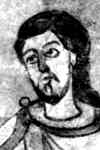
Soběslav I was Duke of Bohemia from 1125 until his death in 1140. He was a member of the Přemyslid dynasty, the youngest son of Vratislaus II, by his third wife Świętosława of Poland.

Vladislaus II or Vladislav II was the Duke of Bohemia from 1140 and then King of Bohemia from 1158 until his abdication in 1173. He was the second Bohemian king after Vratislaus II, but in neither case was the royal title hereditary.

Frederick, a member of the Přemyslid dynasty, was Duke of Bohemia from 1172 to 1173 and again from 1178 to his death.
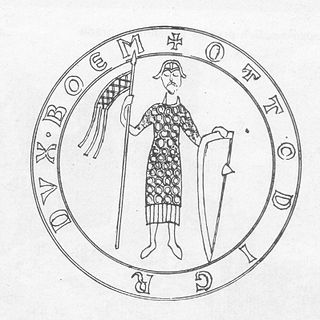
Conrad II Otto, a member of Přemyslid dynasty, was the first margrave of Moravia from 1182 to 1189 and duke of Bohemia from 1189 until his death.
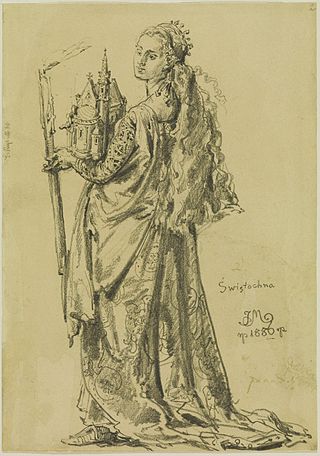
Świętosława of Poland was the third wife of Duke Vratislaus II of Bohemia and the first Queen of Bohemia as of 1085.
Richeza of Berg was Duchess of Bohemia from 1111 to 1117 and again from 1120 until 1125, by her marriage with the Přemyslid duke Vladislav I.

Gertrude of Babenberg, a member of the House of Babenberg, was Duchess consort of Bohemia from 1140 until her death, by her marriage to the Přemyslid duke Vladislaus II.
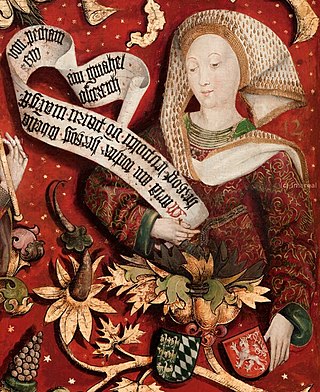
Maria of Bohemia, a member of the Přemyslid dynasty, was Margravine of Austria and Duchess of Bavaria by her first marriage to Duke Leopold I, as well as Margravine of Baden and Verona by her second marriage to Margrave Herman III.
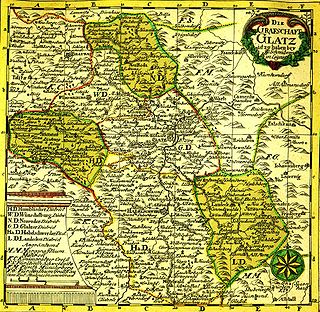
The County of Kladsko was a historical administrative unit within Bohemia as a part of the Kingdom of Bohemia and later in the Kingdom of Prussia with its capital at Kłodzko (Kladsko) on the Nysa river. The territory comprises the Kłodzko Land with the Kłodzko Valley in center within the Sudetes mountain range and roughly corresponds with the present-day Kłodzko County in the Polish Lower Silesian Voivodeship.

The German–Polish War consisted of a series of struggles in 1003–1018, between the Ottonian king Henry II of Germany and the Polish Piast ruler Bolesław I the Brave. The locus of conflict was the control of Lusatia, Upper Lusatia, as well as Bohemia, Moravia and Slovakia. The fighting ended with the Peace of Bautzen in 1018, which left Lusatia and Upper Lusatia as a fief of Poland, and Bohemia became a duchy in the Holy Roman Empire.

Otto II the Black, a member of the Přemyslid dynasty, ruled as a Moravian prince in Olomouc from 1107 and in Brno from 1123 until his death.

Conrad II of Znojmo, a member of the Přemyslid dynasty, was a Bohemian prince who ruled in the Moravian principality of Znojmo from 1123 to 1128 and again from 1134 until his death.
Wratislaus of Brno was the Duke of Moravia from 1125 to 1129 and from 1130 to 1156. He was the first son and successor of Ulrich I, Duke of Brno and an unknown princess. He did not succeed as half monarch of Moravia (diarch), for all half of Moravia as his father Ulrich I, but Brno was already divided into two parts and his father Ulrich was co-monarch with his uncle Luitpold of Znojmo in this part. Both brothers together later established a Benedictine monastery and its St. Procopius Basilica in Třebíč and prepared as mausoleum for the Brno-Znojmo branch House of Přemyslid. Wratislaus himself probably initiated the establishment of the Royal cathedral chapter of St. Peter and Paul in Brno, formally created later in 1292. He reigned over Moravia, once interrupted (1128–1130) by an illegitimate regency of Soběslav I). By his marriage in 1132 to a Russian princess, he probably had two or possibly three children:
This page is based on this
Wikipedia article Text is available under the
CC BY-SA 4.0 license; additional terms may apply.
Images, videos and audio are available under their respective licenses.

















